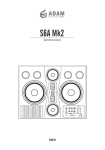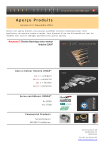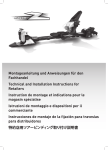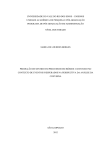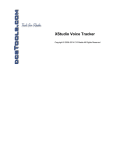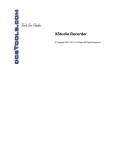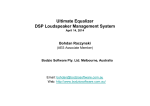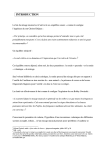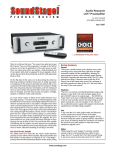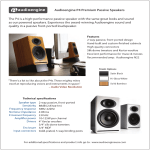Download ADAM - Audiolog
Transcript
5IF8PSMEµT#FTU.VTJD3FDPSEJOH.BHB[JOF This article was originally published in Sound On Sound magazine, December 2008 edition. Sound On Sound, Media House, Trafalgar Way, Bar Hill, Cambridge, CB23 8SQ, United Kingdom Email: [email protected] Tel: +44 (0) 1954 789888 Fax: +44 (0) 1954 789895 Subscribe & Save Money! Visit our subscriptions page at www.soundonsound.com "MMDPOUFOUTDPQZSJHIU4041VCMJDBUJPOT(SPVQBOEPSJUTMJDFOTPST"MMSJHIUTSFTFSWFE 5IFDPOUFOUTPGUIJTBSUJDMFBSFTVCKFDUUPXPSMEXJEFDPQZSJHIUQSPUFDUJPOBOESFQSPEVDUJPOJOXIPMFPSQBSUXIFUIFSNFDIBOJDBMPSFMFDUSPOJDJTFYQSFTTMZGPSCJEEFOXJUIPVU UIFQSJPSXSJUUFODPOTFOUPGUIF1VCMJTIFST(SFBUDBSFIBTCFFOUBLFOUPFOTVSFBDDVSBDZJOUIFQSFQBSBUJPOPGUIJTBSUJDMFCVUOFJUIFS4PVOE0O4PVOE-JNJUFEOPSUIFQVCMJTI FSTDBOCFIFMESFTQPOTJCMFGPSJUTDPOUFOUT5IFWJFXTFYQSFTTFEBSFUIPTFPGUIFDPOUSJCVUPSTBOEOPUOFDFTTBSJMZUIPTFPGUIFQVCMJTIFST NPOJUPST Photo: Mike Cameron POUF TU Adam A5 Active Nearfield Monitors Adam have gained a strong reputation for the quality and value for money of their larger reference monitors, but have they had to make any compromises in their smallest model? Paul White I was intrigued when I heard that Adam were to launch the A5 monitor speaker, as it is effectively the baby brother to the A7 — one of the monitors I use on a regular basis in my own studio. Adam’s unique feature is their folded ART (Accelerated Ribbon Technology) ribbon tweeter, which I’ve discussed at length in reviews of their other monitors. Its concertina-like action moves approximately four times more 42 air than a conventional, flat ribbon of the same frontal area, and this makes it both surprisingly efficient and able to handle frequencies almost an octave above the upper limit of human hearing. In the A5, that same tweeter is teamed with a 5.5-inch woofer, using a cone material that’s fabricated from a sandwich of carbon fibre and a specialist material called Rohacell. This produces a rigid, well-damped cone which, suspended in its soft-roll surround, bodes well for low-end clarity. The drivers are mounted in a neat www.soundonsound.com EFDFNCFS and fairly conventional ported enclosure, with all the connections on the metal rear panel, which also serves as a heat-sink for the electronics. Two small bass ports are located at the lower corners of the front baffle. Design & Construction Adam are clearly aiming the A5 at a wide target audience, with applications including MP3 playback, surround sound, computer games and desktop audio, but don’t let the more frivolous applications distract you from what is, at its heart, a very serious professional tool. Weighing in at 5kg (11 pounds), the magnetically-shielded A5s measure just 285 x 172 x 200mm (11.2 x 6.8 x 7.9 inches). The review model was the ‘Pro’ version, which comes in a business-like matt-black cabinet, but they’re also available in a glossy white or black ‘piano finish’. A perforated metal grille protects the woofer, while the usual slotted metal grille covers the rectangular ribbon tweeter. Both drivers are neatly recessed into the front baffle, which has chamfered corners to match those of the main box. The overall impression is of a very smart and businesslike speaker. Powering the two drivers are two 25W amplifiers, and these are, in turn. driven from an active crossover operating at 2.2kHz. On the rear panel there are controls for adjustment of tweeter speaker. To do this, the slave speaker must have its level control set mid-way, so that you get the correct balance between the two speakers. As soon as the linking cable is connected, a white LED illuminates on the front panel to show the status of the system. You can’t use the monitors balanced in linked mode, but that shouldn’t cause any practical problems in most cases. An optional subwoofer is available, either just to add more bass extension or to complete a 5.1 system using five A5s, and this takes the low end right down to 30Hz. Having said that, though, the A5 ²5IF"TBSFEFGJOJUFMZVQUIFSFXJUIUIFCFTUBOEUIF OFBUMJOLJOHGFBUVSFSFBMMZJTBQMVTGPSBOZPOFSVOOJOH UIFJSTQFBLFSTEJSFDUMZGSPNBDPNQVUFSTPVOEDBSE³ level (±4dB continuously variable), and both 6kHz high-shelving and 150Hz low-shelving filters (±6dB), so that the user can compensate for room placement and personal preference. All three controls require a screwdriver (or tough thumbnail!) for adjustment. Power is delivered via a standard IEC socket, and there’s a recessed switch used to set the mains voltage to a nominal 230V or 115V. The line-level inputs are on the rear panel in both balanced XLR and RCA phono (unbalanced) formats, but the level control is on the front panel, alongside the circular power switch and blue power LED, which makes it easy to access. For those with no separate monitor controller, there are two additional stereo-link RCA phono inputs and outputs on each speaker, enabling the user to link them both via an included RCA phono cable — so you only need feed the stereo line signal from your DAW to one Adam A5 £499 pros UÊGood tonal balance, with no obvious hyping of the low end. UÊCan be controlled from a single front-panel volume control. UÊSensibly priced. cons UÊNo obvious vices — except for the usual bass extension and level limitations inherent in small speaker designs such as this. summary If you like the clarity and honesty of the A7s, you should like the A5s, which have essentially the same family sound but come in a more compact format well suited to smaller mixing spaces. actually turns in a very respectable low-end performance on its own (±3dB 55Hz-35kHz), and in the smaller studio your mixes are less likely to be misleading if the speakers are used without a sub. In fact, the trade-off of having a smaller bass driver isn’t so much less low-end but less overall level. The rating in this respect quotes an SPL of 101dB per pair, using a test sine-wave in the 100Hz to 3kHz range, measured at one metre, and 110dB SPL peak with normal music. Although not as loud as many larger monitors, this is still very loud at nearfield distances — and playback stays clean until well above a level that’s comfortable. Performance With all the filter controls set to flat, the speakers maintained a surprisingly consistent sound with my own A7s, albeit with slightly less bass extension. The bass end is tight and well-controlled — which suggests that the designers have resisted the temptation to over-tune the port to make kick drums sound more impressive than they really are — while the top end exhibits the clarity and fast transient response that we’ve come to expect from the ART folded ribbon. A lot of engineers will love the sound just as it comes, but I initially found the overall tonal balance just a hint too sizzly at the top end for my personal taste. A small adjustment to reduce the tweeter level by around 1dB and to pull down the 6kHz filter by a notch brought the sound neatly into my comfort zone, after which I set about auditioning some test material. It didn’t take long for me to confirm that the A5s really are just slightly scaled-down A7s: they have the same clarity and definition, as well as excellent stereo "MUFSOBUJWFT *GZPVXBOUUPUSZTPNFPUIFSTNBMMOFBSGJFMENPOJUPST UPDPNQBSFXJUIUIF"EBN"TZPVTIPVMEMPPLBU NPEFMTTVDIBTUIF'PTUFY1.B&WFOU"-1,3,31 BOE(FOFMFD" imaging; and given that some of Adam’s speaker models are voiced differently, this is an important point to make. The A5s really are quite revealing, largely due to that unique tweeter — so if anything in the mix sounds a bit off-colour, they’ll tell you, as good monitors should. By the same token, good mixes really shine, and given their size and price, there’s nothing much not to like. Because the woofer is relatively small, the range of the two drivers meets nicely at the crossover point, delivering a confident and comfortable mid range, which is something that can’t always be said of larger two-way monitors, where the woofer is sometimes asked to reproduce frequencies higher than is ideal. In my own studio, which measures 16 by 11 feet, the A7s are probably a better choice than the A5s and obviously have a touch more bass extension, but I’d certainly be able to work on the A5s without any problem. Where the A5s score higher, of course — other than being lower in price — is that they can sit on a desktop and won’t provoke too many low-frequency problems in smaller rooms. Mighty Minis? Of all the small monitors that I’ve tried in this price range, the A5s are definitely up there with the best, and the neat linking feature really is a plus for anyone running their speakers directly from a computer soundcard. As well as being very capable studio monitors in their own right, they’d also work well as part of a surround system, and should actually match the A7s closely enough to work as rears in a system with A7s at the front. Although they’re not exactly budget-priced, the A5s are nonetheless attractively priced for a speaker of this quality, and you also get the reassurance of a five-year warranty. So where you don’t have space for larger monitors, or a suitable room, but you still need a reliable mixing tool, the A5s could be exactly what you need. JOGPSNBUJPO £ T E W W A5 Pro (matt black finish) £499; A5 Piano (gloss black or white finish) £528. Prices per pair including VAT. Unity Audio +44 (0)1440 785843. [email protected] www.unity-audio.co.uk www.adam-audio.de EFDFNCFS www.soundonsound.com 43 PAV136_Adam:PAV135_088-89_AUDIOANALOG 29/04/09 21:06 Page 94 FL A S H T E S T /A DA M AU DIO ADAM AUDIO Enceintes actives A5 et Sub7 Entrées de gamme à la fois professionnelles et Haute Fidelité du constructeur allemand Adam Audio, les enceintes actives A5 complétées par le caisson Sub7 constituent une introduction de choix au son Monitor. Avec cet ensemble compact, le fabricant souhaite aussi séduire tous ceux qui n’utilisent qu’une source musicale unique tel un lecteur de CD, un ordinateur ou un iPod... A dam Audio est un jeune spécialiste de l’enceinte de monitoring qui soufflera ses 10 bougies cette année. Il a présenté l’enceinte active A5 et le subwoofer Sub7 au printemps 2008 à l’occasion du salon Pro Light and Sound de Francfort, en réponse aux besoins en produits miniaturisés de la part des professionnels et des utilisateurs de systèmes home studio. Très intelligemment conçus, ces deux produits à l’étonnant rapport qualité/prix devraient logiquement attirer le Grand Public mélomane mais également séduire un nouveau public, celui des utilisateurs d’iPod ou autres consoles de jeux vidéo à qui ces enceintes font la connectivité belle. Caractéristiques techniques ENCEINTE ACTIVE A5 !PRIX (PAIRE) : 754 € (LAQUÉ), 694 € (NOIR) !HAUT-PARLEUR : boomer de 5 cm à membrane en fibres de carbone et Rohacell, tweeter ART !AMPLIFICATION : 2 x 25 W RMS !RÉPONSE EN FRÉQUENCE : 55 Hz - 35 kHz à +/-3 dB !NIVEAU MAXIMAL : 110 dB SPL/m !DIMENSIONS : 285 x 172 x 200 mm !POIDS : 5 kg CAISSON DE GRAVE ACTIF SUB7 !PRIX : 517 € (LAQUÉ), 481 € (MAT) !HAUT-PARLEUR DE GRAVE : 18 cm à membrane en papier !AMPLIFICATION : 140 W RMS !RÉPONSE EN FRÉQUENCE : 31 Hz - 150 kHz à +/-3 dB !PLAGE DE FILTRAGE : 50 Hz à 150 Hz !NIVEAU MAXIMAL : 107 dB SPL/m !DIMENSIONS : 371 x 200 x 280 mm !POIDS : 8 kg La télécommande du Sub7 agit sur le volume et la fréquence de coupure haute ! DISTRIBUTEUR : MW Distribution (contact en p. 114) 94 Mai / Juin 2009 du subwoofer. Après Abbey Road Studios, chez vous... La jeunesse relative d’Adam Audio n’empêche pas celui-ci d’être reconnu par le monde professionnel comme les studios Abbey Road de Londres ou la salle de concert Mozarteum de Salzbourg en Autriche, pour la qualité et la fiabilité de ses produits. C’est donc tout naturellement que le facteur berlinois a repris les technologies qui ont fait sa réputation, pour réaliser les A5. Cette petite compacte est la première d’Adam Audio vers les applications Grand Public. A cet égard, le carton d’emballage et la fiche technique affichent des photos d’iPod, de manettes de jeux vidéo ou de lecteur de CD raccordés aux enceintes. L’A5 est donc très compacte puisqu’elle mesure 28 cm de hauteur pour 17 cm de largeur et 20 cm de profondeur. Son ébénisterie est en médium à la finition soit noir mat en standard soit laqué blanc ou noir en option. Des supports lourds et inclinés sont disponibles pour ceux qui utilisent les A5 en proximité, ils permettent une orientation des haut-parleurs vers l’auditeur pour améliorer l’image sonore stéréophonique. Quant au caisson de grave, il est installé dans une ébé- PAV136_Adam:PAV135_088-89_AUDIOANALOG 29/04/09 21:07 Page 95 ENCEINTES ACTIVES A5 ET SUBWOOFER SUB7 nisterie recevant les mêmes finitions que l’A5 mais logiquement plus volumineuse que la compacte. Chaque A5 et le Sub7 sont livrés dans des emballages séparés comprenant un cordon secteur, un cordon de modulation RCA-RCA d’une longueur de 2 m (uniquement avec les A5) et une notice bilingue anglais et allemand très didactique. Des technologies de pointe Le rapport qualité/prix des A5 s’avère stupéfiant car pour moins de 700 € la paire en finition standard, les A5 vous offrent des technologies de premier ordre. Le haut-parleur de grave-médium de 15 cm de diamètre dispose d’une membrane en sandwich de fibres de carbone et de Rohacell protégée par une grille métallique finement perforée. Il est chargé en bassreflex avec deux évents débouchant au bas de la face avant. Le tweeter reprend la technologie propriétaire ART d’Adam Audio, pour Accelerating Ribbon Technology. Ce tweeter est basé sur les travaux du docteur Oscar Heil qui donnèrent naissance, en 1972, au haut-parleur AMT (Air Motion Transformer). Sa membrane plissée produit un déplacement de l’air quatre fois plus rapide qu’avec une membrane travaillant en piston, grâce à l’effet de compression des plis. De plus le circuit magnétique fait de plusieurs barreaux de néodyme contribue à la sensibilité élevée du transducteur. L’amplification est confiée à deux amplificateurs de 25 W directement raccordés aux haut-parleurs, le filtrage autour de 2 200 Hz est placé en tête des amplis. A l’arrière, on trouve deux entrées analogiques (une RCA et une XLR), une entrée RCA et une sortie RCA Stéréo Link et trois contrôles de niveau soit un pour le tweeter et deux «Room Eq» pour l’égalisation sous 180 Hz et audessus de 4 kHz. Le Stéréo Link est un système maître/esclave du réglage de niveau sonore de deux A5 à partir du réglage de volume d’une des deux. Le Sub7 intègre un amplificateur de 140 W alimentant un boomer de 18 cm de diamètre à membrane en papier et large suspension en demi-rouleau. Monté en bassreflex, il dispose d’un filtre réglable par molette en face avant entre 50 et 150 Hz, une seconde molette réglant le volume du Sub7. La face arrière reçoit une entrée stéréo «input» et une sortie stéréo après filtrage «satellite out» RCA et XLR ainsi que trois poussoirs pour la mise en service d’un filtre fixe à 85 Hz pour les satellites, le réglage de la phase du subwoofer et du mode d’allumage et d’extinction automatique. Une télécommande permet les réglages à distance de la fréquence du filtre et du niveau sonore du caisson. teur et avons positionné le point d’écoute et les A5 en triangle équilatéral pour obtenir une scène sonore superbe de volume et de relief. Avec le Sub7, le grave gagne certes en assise mais son réglage de niveau s’avère délicat car des bruits d’écoulement d’air apparaissent rapidement dans l’évent cylindrique si on monte le niveau. Toutefois, l’ensemble reste cohérent en écoute à niveau domestique. Conclusion Les Adam Audio A5 et le Sub7 constituent une véritable passerelle entre le professionnel, l’audiophile et le fanatique de la console et de l’iPod. Les performances sonores sont incroyables, la qualité de fabrication est toute germanique et les technologies mises en œuvre parmi les plus évoluées du moment. Avant tout achat et aux prix proposés, il serait vraiment impardonnable de ne pas aller les écouter ! Pierre-André Viollet A l’écoute EN DIRECT DU LABORATOIRE > Nous avons utilisé les A5 seules, puis raccordées au Sub7 avec filtrage à 85 Hz (recommandé par Adam Audio). Seules, les A5 produisent un son d’une ampleur, d’une rigueur tonale et d’une aération peu communes au regard de leur taille. Le grave est étonnamment articulé et sa descente surprend à tel point que la question de l’ajout d’un caisson pourra se poser. Certes l’impact subjectif d’une frappe de timbale ne prend pas des dimensions réalistes mais l’effet ressenti crée une réelle illusion même à des niveaux sonores élevés. La qualité de timbres épate avec une douceur et une précision plus monitor que Hi-Fi, la définition et le rendu des détails sont très au-dessus de la moyenne grâce à la méticulosité d’analyse du tweeter. Nous avons suivi les conseils du construc- Mesures enceintes Adam Audio A5 Distorsion à 84 dB/1m 0,95 % (100 Hz) 0,15 % (1 kHz) 0,13 % (10 kHz) Réponse en tiers d’octave de la A5 Remarquable linéarité de réponse, logique vu le pedigree du fabricant. Le grave flirte avec le 60 Hz à -3 dB... L’amplification des A5 est confiée à deux circuits intégrés de puissance placés entre deux plaques épaisses en aluminium massif (à droite). A gauche, on distingue les composants CMS des circuits de filtrage, de préamplification et du système Stereo Link. Réponse dans le grave du Sub 7 Energie très bien répartie sur toute la bande reproduite sans effet «pain de sucre». 95 Mai / Juin 2009 KR233_092-093_Test_AdamA5:KR232_086-087_Test_AdamA5 20/08/08 15:08 TESTS > AUDIO PRO Page 92 Moniteur de studio amplifié 2 voies ADAM A5 La petite dernière Dévoilée lors de la Musikmesse, la « petite » A5 arrive enfin chez nous. Elle utilise les technologies de ses grandes sœurs, dans une optique studio/hi-fi/multimédia, et complète la gamme proposée par Adam. CARACTÉRISTIQUES > Fabricant : Adam > Produit : A5 > Type : Moniteur de studio amplifié, 2 voies > Distributeur : MW Distribution > Sites : www.adam-audio.com, www.mwd.fr > Prix TTC : 347 € pièce (noir mat), 377 € pièce (laqué noir ou blanc) L e fabricant allemand Adam s’est révélé par ses enceintes assez inhabituelles voici quelques années. Sa gamme est vaste, pas limitée au marché professionnel et la qualité de restitution bien particulière a attiré nombre d’ingénieurs du son et de producteurs, qui installent souvent des S3A dans leur project-studio. Voici deux ans environ, le « petit » modèle A7 visait déjà le marché du home-studio. Dévoilé en mars lors du Pro Light & Sound, revu à l’AES d’Amster- De gauche à droite : noir mat, laqué blanc et laqué noir 92 • KR home-studio - septembre 2008 dam, l’A5 est encore plus petit, et constitue la première incursion de la marque dans des applications « mixtes » : le carton d’emballage mentionne « Studio Multimédia Monitor », l’enceinte propose des connecteurs RCA (grand public, donc) et un réglage commun du niveau d’écoute des deux enceintes. Enfin, outre la finition noir mat habituelle, on peut accéder, moyennant 30 euros supplémentaires, à une finition laquée noire ou blanche, parfaitement assortie à un iPod ! Et les supports assortis pour bureau sont à 55 euros les deux. Autrement dit, les A5 sont destinées à ceux qui utilisent leur ordinateur comme source sonore, au sens large du terme… Les photos du carton représentent d’ailleurs les enceintes posées près d’un iMac, reliées à un iPod, ou encadrant une surface de contrôle, mais aussi près d’une console de jeux et d’un lecteur de CD. Fort bien, mais dans ce cas, pourquoi ne pas aller jusqu’au bout, en proposant une liaison via USB ? KR233_092-093_Test_AdamA5:KR232_086-087_Test_AdamA5 20/08/08 15:08 Page 93 Débutant Amateur Confirmé Pro Studio Outre la finition noir mat habituelle, on peut accéder, moyennant 30 euros supplémentaires, à une finition laquée noire ou blanche, parfaitement assortie à un iPod. FICHE TECHNIQUE Entrées : XLR et jack Nombre de transducteurs : 2 Diamètre boomer : 147 mm, alliage aluminium Tweeter : à ruban ART Amplificateurs : 25 + 25 W Réponse en fréquence : 55 Hz à 35 kHz Niveau SPL maxi : 110 dB SPL la paire, à 1 m, crête Dimensions : 172 x 285 x 200 mm (L x H x P) Poids : 5 kg Les dimensions de ces moniteurs sont réduites : 17 x 28 x 20 cm, pour un poids de 5 kg. UN AIR DE FAMILLE… De l’énorme encastrable S7A MkII (20 000 euros pièce !) à l’A5, les moniteurs Adam partagent des boomers à la membrane sophistiquée et des tweeters à ruban d’un modèle spécifique, ART (Accelerated Ribbon Technology). Le « 5 » de la référence signifie que le diamètre du boomer est de 5 pouces – enfin, 5 1/2, soit 147 mm, comme le proclame fièrement le mode d’emploi. Protégé par une grille que nous trouvons assez laide, il est toujours en fibres de carbone et Rohacell, et chargé par un double évent débouchant en bas de l’enceinte, à l’avant. Le tweeter est un modèle à ruban plissé ART, spécialité de la marque, d’une surface équivalente de 710 mm2. À titre de comparaison, la surface d’un tweeter de 25 mm conventionnel est de 490 mm2. La réponse en fréquence annoncée s’étend de 55 Hz à 35 kHz, le raccord entre les HP s’effectuant à 2,2 kHz. Les dimensions sont réduites : 17 x 28 x 20 cm, pour un poids de 5 kg. L’enceinte deux voies est amplifiée (2 x 25 W efficaces), et dotée de connecteurs d’entrée XLR et RCA (pas de jack à l’horizon). Originalité de l’A5 : des connecteurs cinch assurent la liaison Speaker Link entre l’enceinte gauche et la droite (un câble de liaison d’une longueur de 2 mètres est livré avec chaque enceinte). D’emploi facultatif, cette fonction permet de régler le niveau sonore des deux enceintes via le potentiomètre en face avant d’une seule – la Master, celle d’où part le câble RCA Speaker Link, et dont la LED blanche témoin s’allume. Signalons d’ailleurs que le potentiomètre de volume, assez facile à manier, est cranté au centre : une bonne idée en soi, mais à quoi correspond ce cran ? Simple : en mode Stereo Link, il correspond à l’équivalence avec le volume de l’enceinte Master, au « gain unitaire » en quelque sorte. Le mode d’emploi, en anglais et allemand seulement, est succinct, mais pas mal fait – donnant des conseils de placement, explications et courbes correspondant aux correcteurs Room EQ du panneau arrière (±6 dB au-delà de 6 kHz ou en dessous de 150 Hz, la valeur en dB étant relevée respectivement à 30 Hz et 15 kHz). Ces deux-là agissent sur toute une bande de fréquences. Un troisième correcteur d’aigus fait basculer la courbe de réponse à 6 kHz selon un mode Shelve standard, de ±4 dB lui aussi. L’efficacité est parfaitement perceptible. Chez nous, l’enceinte a donné les meilleurs résultats en position neutre. IMPRESSIONS D’ÉCOUTE Hasard du planning, nous avions chez nous, en même temps que les A5, les Acoustic Energy AE1 Classic. Il s’agit là d’enceintes passives, d’un prix supérieur, mais la comparaison est intéressante. AE1 comme A5 ne se plaignent pas quand on monte le niveau – le volume sonore atteint avant signes ostensibles de souffrance des membranes est assez impressionnant compte tenu du volume des enceintes ! Les A5 descendent de façon réaliste dans le grave, même si un 5 pouces ne peut faire illusion longtemps sur une grosse caisse ou des loops bien grasses. C’est sûr, nous avons entendu Jon Hassel avec des graves plus solides. Et nous nous demandons si quelques Watts de plus pour le boomer n’auraient pas constitué un plus… L’aigu semble en retrait par rapport à celui des AE1, plus projeté, plus hi-fi. Il est pourtant bien présent, mais tout en Les supports assortis pour bureau sontà 55 euros les deux. douceur, comme toujours chez Adam. L’habitude d’écoute vient vite, et la définition est bien là, avec un velouté qui peut être trompeur quand on ne connaît pas la marque. La profondeur du mixage se manifeste d’emblée quand on est bien placé, et l’impression de relief est marquante, basée sur le respect des premières réflexions et des délais. Rien n’agresse sur les A5, et l’image stéréo se déploie largement, même si les AE1, exceptionnelles dans ce domaine il est vrai, donnent à la fois plus d’ampleur et de discrimination. En utilisation multimédia, attention à laisser les enceintes suffisamment écartées : plus d’un mètre, minimum… DÉFI RELEVÉ Pourquoi Genelec serait-il le seul à décliner ses modèles actifs de studio vers le multimédia ? Avec l’A5, Adam relève le défi avec panache, pour un prix abordable : 347 euros TTC pièce en finition noir mat, 377 euros en finition laquée, noire ou blanche. À rapprocher du modèle immédiatement supérieur, l’A7 (499 euros). Celui-ci descend un peu plus bas dans le grave, mais son encombrement est supérieur, et on perd la dimension multimédia. Adam propose un caisson de graves de complément, le Sub 7, 140 W et boomer de 175 mm (non écouté) : 481/517 euros TTC. Franck Ernould POUR > Concept, look en version laquée > Grave présent et pas trompeur > Fonction System Link bien pratique > Niveau sonore impressionnant pour le volume ! CONTRE > Grille du boomer laide > Pas de réglage de sensibilité sur les connecteurs d’entrée eux-mêmes > Pourquoi pas une liaison directe USB, si le modèle est multimédia ? EN RÉSUMÉ Une déclinaison vers le bas réussie. Sans trahir ses concepts de base, Adam propose un modèle ouvert sur le multimédia, facile à utiliser avec un ordinateur. La liaison USB eût été un plus dans cette optique… Restitution toute en douceur mais énergique, bonne volonté, belle image sonore : bien joué ! KR home-studio - septembre 2008 • 93 Adam A5 Recording Studio Monitor Are you willing to find the tr... Home Partner Magazines Show Reports http://www.enjoythemusic.com/magazine/equipment/0908/adam_... Review Magazine Search Superior DIY Site Audio September 2008 Adam A5 Recording Studio Monitor Are you willing to find the truth in your music collection? Review By Steven R. Rochlin Click here to e-mail reviewer The Adam A5 is not an audiophile loudspeaker. Now before you died-in-the-wool audiophile-types stop reading, in perhaps a massive error of quick judgment, the Adam A5 recording studio monitor is so good that every audiophile should go right out and hear these amazing units. Longstanding readers of my reviews know that when i make a statement as bold as this so early within a review it can only mean you are about to learn about a truly outstanding product. So yes i will boldly say, perhaps in defiance at possibly insulting some readers, that this is not an audiophile product and that every audiophile should take note of the Adam A5 in a big way! Perhaps it is time to get audiophiles off their painted pony gear and enjoy another way of listening to their prized music collection. Specifically, for you to 'listen' in the same manner professional recording studio engineers create music to make a living (or at least squeak by on the meager paycheck provided by the major record labels). If you are seeking the truth, my ears tell me that the Adam A5, priced at a humble $699 per pair in matte black finish or $769 in glossy white or black, offers an amazing value. What you will not get is Harbeth-like LS3/5 fake bass extension by boosting the midbass, you will not get that silky dome tweeter smoothed highs, and you most certainly will not get any resemblance of deep bass below the truthfully specified 55Hz (± 3 dB). You can forget about the fabled Western Electric 300B rose-colored glasses, the faking of pinpoint imaging tricks by boosting of the frequency response within the upper midrange frequencies. Lastly, there is no way for you to easily remove the built-in amplifiers to insert your flavor-of-the-month club amplifier. In fact there is no need for a preamplifier either, as you can simply plug in your source component and enjoy the music (plug and play). The audioengine A2 (reviewed here) does not stand a chance in comparison and the larger audioengine A5 (reviewed here) got relegated back to their packing boxed and are now located deep inside my attic. You audiophiles know what i mean, that place in your home where 'dead' gear goes until you either finally sell it or, better still, give it away to a relative as a reboxed gift. The first time i saw the Adam A5 recording studio monitors was at the 2008 High End Society show in Munich. This must-attend event, apparently largely ignored by many America-based high-end companies, is where many millions of dollars of business each year comes to light. Both members of the press and the public at large get to see and hear a staggering array of excellent products. Among the new products launch at the show was Adam's A5, and as a studio musician in a earlier life it was obvious there was something very special going on 1 von 7 23.10.2008 13:59 Uhr Adam A5 Recording Studio Monitor Are you willing to find the tr... http://www.enjoythemusic.com/magazine/equipment/0908/adam_... here. So i immediately asked for a review pair and what you are about to read is the outcome. So what makes the Adam A5 so good? Sum Of The Parts Ok, a play on words there as the "sum of the parts," or perhaps i mean "some of the parts"? It matters not as the smallest model within the Adam Studio Monitors follows their successful larger brother, the A7. The A5 uses the same proprietary Accelerating Ribbon Technology (ART) tweeter and the same type of woofer, consisting of a sandwich construction carbon fiber and Rohacell yet in a reduced 5.5-inch cone. Each cabinet has a pair of 25 Watt amplifiers, one each for the tweeter and woofer. While the woofer is quite interesting, i'd like to focus on the ART tweeter. Adam has plenty of technical information and there is no need for me to retype the obvious. So here are some of the basics, "The ART (Accelerating Ribbon Technology) tweeters units take a completely new approach in kinematics to move air and improve the quality of music reproduction. Based on the original works of Dr. Oskar Heil, who invented his "Air Motion Transformer" back in 1972, new electroacoustic transducers have been developed that are based on improved layouts and new materials. The membrane consists of a lamella like folded diaphragm whose single folds move according to the alternate current, thus squeezing air in and out. All other loudspeaker drive units, whether they are voice coil driven, electrostatics, piezos or magnetostatics, act like a piston, moving air in a 1:1 ratio. This is undesirable, as the specific weight of air is much lower than that of the driving mechanics. Speaking in terms of electrical Engineering one could say there is a bad match between source and load. The ART principle achieves a 4:1 velocity transformation between driving diaphragm and driven air, i. e. the air moves in and out four times faster than the folds itself are moving. This superior "motor" is responsible for the enormous clarity and transient reproduction that is to be heard from the ART drive units." "Besides the transformation advantage the construction of the membrane in single stripes avoids the typical break up of stiff domes or cones at higher frequencies and the resultant dynamic limiting. Another factor in dynamics is diaphragm area. What you see is what you get. The cone area you can see is always the acoustically active area of the loudspeaker - this is true for practically all other drive units. By folding the ART diaphragm into the third dimension as seen from the listener's position a much larger folio can be used. A factor of more than 2.5 can be seen between the sound generating area and the acoustically effective area of the diaphragm. Thus a smaller movement is needed for a given sound pressure level, enabling the unit to reach a higher sound pressure level without dynamic compression." To learn more, see Adam Audio's website plus Enjoy the Music.com has reviewed Oskar Heil's Kithara (reviewed here) and Harmonious loudspeaker (click here). Unlike most audiophile loudspeakers, the rear side of the Adam A5 has a panel with numerous adjustments to adapt the loudspeaker to the specific room acoustics or personal preferences. The tweeter level can be adjusted ± 4dB, the "Room EQ" at >6kHz of ±6dB and <150Hz of ±6dB. There are both balanced (XLR) and unbalanced (RCA) inputs to ensure connectivity to virtually any application in 2 von 7 23.10.2008 13:59 Uhr Adam A5 Recording Studio Monitor Are you willing to find the tr... http://www.enjoythemusic.com/magazine/equipment/0908/adam_... professional studios or at home. While each powered monitor has a volume adjustment knob, Adam provided a special Stereo-link feature. This allows users to adjust the volume of both loudspeakers with only one control to ensure a balanced volume level. The A5 is offered in flat black or high quality piano finishes (black and white). Adam also sent me a pair of their desktop/table stands that angles the speaker, yet they were not employed within this review as i have my own type of stand so that the loudspeaker height it at the optimum level. While many users could place the speakers on a table, thereby causing early sound reflections (time distortion) as the sound 'bounces' off the table surface, i use a wood shelf that brings the speakers up to the desired height. Speaking of which, i found the best sound to be when the woofer's top mounting bolt was at ear level. It has been a few years since my ears have enjoyed great ribbon-like tweeters. Have owned the then new Infinity RS6000, then tried the RS IIB (with audiophile tweaks)... and finally the Magnepan MG 3.6. Yes the Heil is different and yet i find many of the great things i love so dearly about to-end ribbons to translate to the Adam A5. It is also obvious by the music i tend to gravitate towards when reviewing a product that is quite telling. Right out of the box the A5 monitors were impressive. After about 100 hours i did note the tweeter settled down a bit and the overall sound became more unified. In my setting, the final rear adjustments were +1.5dB for the Tweeter and +3dB for Room EQ <150Hz. Cabling was the Kimber GQ-Mini CU that was fed sound material by my computer's 24-bit/192kHz sound card or the Emmeline Predator (reviewed here). before i forget, one of the 'tricks' in setting up any speaker system, especially nearfield monitors as small difference are a larger percentage versus far-field, is precision in setup. You want everything to be exactly spaced in all dimensions. Truth In Sound When first hooking up the Adam A5 the first thing that came to mind was how the sound they produced reminded me a lot like that of all the time i spent in the recording studio. There is a great truthfulness in the way they sound. Unlike, say, either the audioengine models or the fabled LS3/.5 monitors, you do not get slightly boosted midbass so that the music sounds fuller than it truly is. While this may be a asset with the audioengine 2 so as not to sound anemic, it is a neat trick to fool the ear into thinking there is more 'there there. The Adam A5 refuses to tell such fibs, instead it produces the lower frequencies down to an honest 55Hz (± 3 dB) and then nearly refuses to give you much than what is truly there within the input signal. If you want more deep bass, you'll want to spring for the company's subwoofer module or the like. Then again 55Hz should be more than fulfilling for desktop monitors unless you are a pipe organ freak or into those car audio techno bass songs and such. Even my listing to various Kraftwerk discs was very enjoyable, with only a very rare moment or two of missing out on the very last octave or so. As i said before, that is why Adam and many other companies offer subwoofers for monitor loudspeakers. But enough about the bass, let us climb up the frequency ladder to the all-important midrange. Wow! That about sums it up, yet am sure if i left it there you'd be e-mailing me asking for more information so here it goes. On the London Symphony Orchestra's Nutcracker Suite (Mercury Living Presence 35MM) it was overwhelming enjoyable how well the string, woodwind, and horn sections sound so very convincing. In fact i could easily hear some of the mastering manipulation quite clearly. Each instrument's natural tonality and harmonics were easily discernable. There was virtually none of that "My brain needs to adding a bit more information at the leading edge of the sound". It all simply was there to be heard. Time and again this same sentiment was echoed on other classical music titles both modern and vintage where appropriate and properly recorded. The classic Nat King Cole song "Mona Lisa" is a great test of many things, including a soothing voice and strings. While not a modern 3 von 7 23.10.2008 13:59 Uhr Adam A5 Recording Studio Monitor Are you willing to find the tr... http://www.enjoythemusic.com/magazine/equipment/0908/adam_... 'audiophile' recording, it is quite challenging in its own ways. Same with the song "L-O-V-E". The Adam A5 did an outstanding job at clarity, speed, and in producing what is within the recording. As for a modern recording of vocals, one of my favorites is Lavern Butler's "Isn't It A Pity [Chesky Records]. Her voice comes through with such a stunning 'thereness' that her voice truly captivates the listener. Of course the remainder of the music is also extremely well recorded, as is expected from this great audiophile label. And yes, Nora Jones' "Come Away With Me", a recording that has perhaps become a type of standard to some, is mesmerizing in how well her voice and the supporting musicians come into play. As such, these little monitors sound so direct and straightforward. If you are seeking a more romantic (read: false) portrayal, then other monitors may be more to your liking. It is not that the Adam A5 strips out the sheer delicacy and seduction of this recording, far from it! You get what you put into these little jewels, with extremely little added or taken away. Moving on to the uppermost frequencies, here is where the proprietary Accelerating Ribbon Technology (ART) tweeter shines, and proves itself a justified following among audiophiles and studio engineers alike. My years of enjoying the Infinity loudspeakers, now long gone, and the Magnepan MG 3.6 (reviewed here) has truly made me miss the way such upper frequency devices deliver the goods. On Kraftwerk's The Mix songs "Abzug" and flows into the song "Metal On Metal" are great examples of how these ultra-high frequencies are delivered in comparison to other tweeter technologies. Without any excuse i will admit to loving silk soft-dome tweeters, as the as they generally produce the extremely high frequencies may be a bit foreshortened, yet they do not become irritating as i find with many metal dome types. Have not played with many ceramic tweeters to give a full judgment, and yes and all generalizations will be considered wrong at one particular point or another. So please take my comments here as a generalization that does not apply 100 percent of the time to all such devices. Still, Kraftwerk's music has a staggering speed and transparency in both sound and phase that to my ears seems hard to equal with done types. Why? i simply am not an engineer and am here to present my opinions and experience. As such, my ears tell me that the Adam A5 tweeters are very impressive and confirm why so many audiophiles form a following to ribbon and Heil type devices. Soundstaging ergo imaging you ask. Excellent, as is the rendering of the real or recording engineered fake ambience. At times i do wonder if audiophiles are really to truly hear what is so close to precisely what is within their music. It reminds of of during my early days of home theater, the then King-Of-The-Hill Lexicon CP-1 was mated to a staggering array of Theta digital equipment, conrad-johnson, VTL and Adcom amplification and eight Infinity loudspeakers plus an M+K MX2000 subwoofer. The reason i go into detail here is that during the laserdisc days, the surround sound mastering was such that even movies like Star Wars and the Terminator would become audibly distracting. Why? Because when i could easily hear so much information it was, in turn, easy to hear all the problems of misalignment of the voice to the video, the artificialness of the voice tracks, the fake acoustics they tried to wrap around the voice, etc. In one movie the main voice track would begin a millisecond or so ahead of the actor, and by the end of the disc the sound was a millisecond or two behind! There were other anomalies, as the movie's sound engineer had to deal with 64+ tracks of audio and attempted to somehow make it all 'work'. ARGH! While i have no major critics of the Adam, i will say to avoid using the Stereo Link feature, as the addition this element seems to diminish the clarity and the imaging suffers (plus at very low volumes the Stereo Link does not work well, with one speaker basically not making any sound whatsoever). A minor point is that microdynamics are a bit compressed, though overall the dynamics and hearing many instruments within the mix is very impressive. On one end i can hear amazing small details and layer after layer of various instruments within a song and/or classical piece. It is amazing to hear very small things 4 von 7 23.10.2008 13:59 Uhr Adam A5 Recording Studio Monitor Are you willing to find the tr... http://www.enjoythemusic.com/magazine/equipment/0908/adam_... far quieter in volume than the main or solo instrument or vocal. On the other end is the lack of the super small dynamic shadings. Color me perplexed how this is so, yet that is what my ears are telling me. At the 2008 Munich High End show i heard Adam's larger offerings and detected no problems with dynamics in any sense. In fact the music was so impressive i sought out to review the A5 and hope to review one of the company's larger siblings at some point in the future. Oh, and you PRAT lovers will be very pleased that all my funky music did indeed dance and swing. So Is This Speaker For You? A valid question as there are times i wonder if audiophiles truly want to hear everything within their recordings. Don't get me wrong, we all want to extrapolate as much information as possible and, in turn, seek high-resolution audio formats and constantly tweak this and upgrade that. Yet if every single coloration was removed, would you find yourself enjoying the music or annoyed by the sheer truth of information? The Adam A5 produces a very direct window into the music. As such, it has brought me hundreds of hours of musical bliss and in rediscovering some of the greatness in minimally mic'ed recordings. It has also shown me the engineering errors in others. To deliver such impressive results, driver technology and features for a relatively low price tag is truly an triumph! The Adam A5 speakers are so good they will be residing in my digital audio/video workstation for engineering and mastering duties! They are also receiving my highest value of Blue Notes within the Review Magazine ratings, a feat not to be easily dismissed from this longtime musician and audiophile enthusiast! Add to that, am awarding them my one and only personal vote for Best Of 2008 Blue Note Equipment Awards. As always in the end what really matters is that you... Enjoy the Music, Steven R. Rochlin Tonality Sub-bass (10Hz - 60Hz) Mid-bass (80Hz - 200Hz) Midrange (200Hz - 3,000Hz) High Frequencies (3,000Hz On Up) Attack Decay Inner Resolution Soundscape Width Front 5 von 7 23.10.2008 13:59 Uhr Adam A5 Recording Studio Monitor Are you willing to find the tr... http://www.enjoythemusic.com/magazine/equipment/0908/adam_... Soundscape Width Rear Soundscape Depth Behind Speakers Soundscape Extension Into Room Imaging Fit And Finish Self Noise Value For The Money Specifications Type: Two-way recording studio monitor active bass reflex design Tweeter: ART Technology Woofer: 5.5-inch Rohacell / Carbonfibre Frequency Response: 55Hz to 35kHz (± 3dB) Built-in Amplification:25 Watt x 2 (RMS) Inputs: XLR or RCA Dimensions: 6.8 x 11.2 x 7.9 (WxHxD) Weight: 11 lbs. Warranty 5 years Price: $699 per pair in matte black finish or $769 in glossy white or black Company Information Adam Audio GmbH Lobeckstr. 36 10969 Berlin-Germany Voice: +49 30-863 00 97-0 Fax: +49 30-863 00 97-7 E-mail: [email protected] Website: www.adam-audio.com USA Distributor Adam Audio USA Voice: (818) 991-3800 Fax: (818) 991-3803 E-mail: [email protected] Add Us To Your Favorites Link Your Website To Us Make Us Your Homepage Audiophile Internet Browser V9.1 Now Available! Our free content is greatly helped with your kind support. 6 von 7 23.10.2008 13:59 Uhr
















